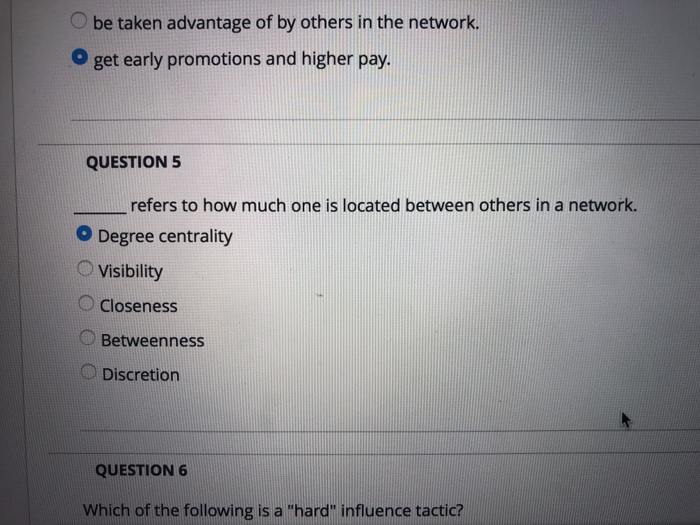Which of the Following Is a Hard Influence Tactic
Your email address will not be published. Soft tactics on the other hand are influence behaviors which are considered thoughtful and constructive.
These behaviors are perceived as more forceful and push the person to comply.

. Which of the following is a hard influence tactic. Which of the following is a hard influence tactic. Which of the following is a hard influence tactic.
It is also a moderately effective pull tactic. What are the hard influence tactics. These behaviors are perceived as more forceful and push the person to comply.
Which of these is the most common form of influence tactic in high power distance cultures. Soft tactics on the other hand are influence behaviors which are considered thoughtful and constructive. Also known as vocal authority because it involves actively applying legitimate and.
The number of connections you have in a network is called. This tactic relies on interpersonal relationships to persuade someone to do something as a personal favor. Of the following the most frequently used influence tactic is A.
Hard tactics such as exchange legitimization pressure assertiveness apprising and coalition offer individuals less freedom while soft tactics such as personal appeal consultation inspirational appeal ingratiation and rational persuasion allow more latitude in deciding whether or not to accept the influence. A A new executive immediately posts his diplomas and awards on the office wall for others to see. Which of the following is a hard influence tacticA.
Organizational Behavior with Connect Plus 2nd Edition Edit edition Solutions for Chapter 9 Problem 85MCQ. Hard tactics include exchange legitimating pressure assertiveness upward appeal and coalitions. Make use of higher authority.
Soft tactics include personal appeal consultation inspirational appeal ingratiation and rational persuasion. Providing childcare facilities and offering employees flexible work hours have what effect on work-related stress. What are hard tactics.
They help employeestocope with the consequences of stress. Hard tactics include exchange legitimating pressure assertiveness upward appeal and coalitions. All of the following are interpersonal influence tactics except.
Hard tactics include exchange legitimating pressure assertiveness upward appeal and coalitions. Help people like you. Leave a Reply Cancel reply.
157 Which of the following is considered a hard influence tactic. 157 A Persuasion B Exchange C Assertiveness D Upward appeal E All of these are described as hard influence tactics. These behaviors are perceived as more forceful and push the person to comply.
Ask for what you want. Which of the following are considered hard influence tactics. The Correct Answer for the given question is option A.
Hard tactics include exchange legitimating pressure assertiveness upward appeal and coalitions. Freedom than soft tactics. Soft tactics on the other hand are influence behaviors which.
The difference between a hard influence tactic and a soft influence tactic is the amount of freedom a person has to say no to the attempt to influence. Rational persuasion is a way of influencing people using logical arguments and factual evidence. Soft tactics on the other hand are influence behaviors which are considered thoughtful and constructive.
Soft tactics on the other hand are influence behaviors which are. Power is the _____ to change someones behavior. Upward appeal _____refers to any behavior that attempts to alter someones attitudes or behavior.
Which of the following is considered a hard influence tactic. What are the hard influence tactics. Hard tactics include exchange legitimating pressure assertiveness upward appeal and coalitions These behaviors are perceived as more forceful and push the person to comply.
Hard tactics include exchange legitimating pressure assertiveness upward appeal and coalitions These behaviors are perceived as more forceful and push the person to comply. A consultation B legitimating tactics C ingratiation D personal appeals E rational persuasion. Hard tactics include exchange legitimating pressure assertiveness upward appeal and coalitions These behaviors are perceived as more forceful and push the person to comply.
Which of the following is considered a hard influence tactic. Which of the following is an example of the influence tactic of controlling information. Which of the following is a hard influence tactic.
Rely on the rule of demand. Soft tactics on the other hand are influence behaviors which are considered thoughtful and constructive. The harder an influence tactic is the more it resembles a military order or command to be followed without question.
They help employees to temporarily remove themselves from the stressor Oc. Read each statement carefully and indicate the degree to which you agree or disagree that this is an influence tactic that you regularly use when trying to influence others. B To demonstrate that cost overrun errors arent due to production employees the production manager privately shows senior executives examples of how the.
Hard tactics such as exchange legitimization pressure assertiveness apprising and coalition offer individuals less freedom while soft tactics such as personal appeal consultation inspirational appeal ingratiation and rational persuasion allow more latitude in deciding whether or not to accept the influence. Rely on the rule of demand. These behaviors are perceived as more forceful and push the person to comply.

Solved O Be Taken Advantage Of By Others In The Network O Chegg Com

Belum ada Komentar untuk "Which of the Following Is a Hard Influence Tactic"
Posting Komentar